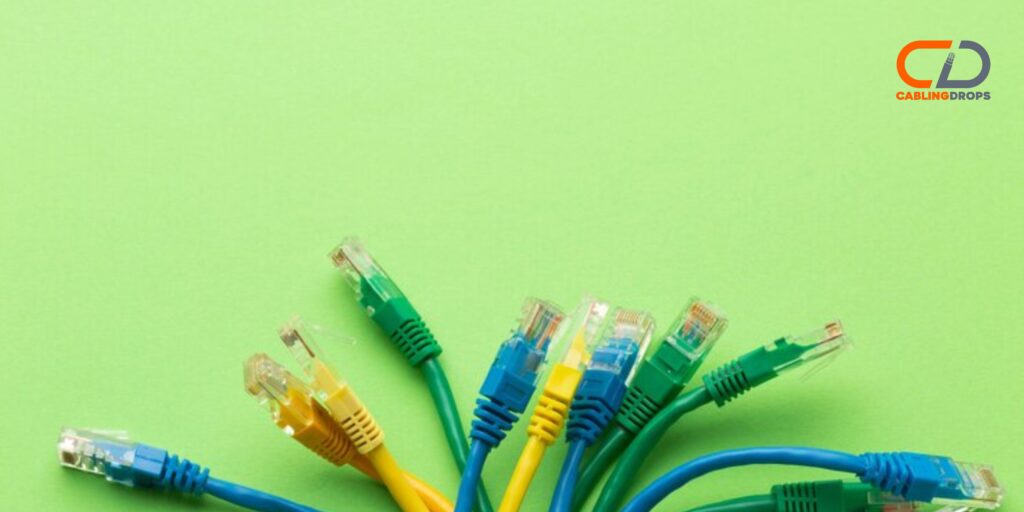
Table of Contents
Request A Quote Today!
"*" indicates required fields
Choosing the appropriate cables is essential in the networking industry to guarantee maximum performance and dependability. Cat6a network cables have been a popular option for many applications due to the increasing demand for faster speeds and better connectivity. In this article, you’ll learn all there is to know about Cat6a cables, including their advantages and how to choose Cat 6a ethernet cable installer in New Jersey.
What is Cat6 Network Cable?
Category 6, commonly called Cat6 ethernet cable, is a standardized twisted pair cable used for Ethernet and other network physical layers. It was introduced to the market in the early 2000s as a successor to the Cat5e standard, offering improved performance and reduced interference. Cat6 cables are designed to support data transfer rates of up to 1 gigabit per second (Gbps) over a maximum distance of 100 meters.

One of the key features of Cat6 cables is their ability to operate at a frequency of up to 250 MHz. This higher frequency compared to Cat5e (which operates at 100 MHz) allows Cat6 to carry more data and reduce crosstalk, which is the interference caused by adjacent cables. The reduction in crosstalk results in clearer and more reliable signal transmission, making Cat6 cables suitable for environments where network performance is critical.
Cat6 vs. Cat6a: What’s the Difference?
Cat6a, or Augmented Category 6, builds upon the foundation of Cat6 cables but with enhanced capabilities. The “a” in Cat6a is “augmented,” indicating improved specifications. While Cat6 cables support up to 1 Gbps, Cat6a cables can handle data rates up to 10 Gbps over the same 100-meter distance. This makes Cat6a cables a superior choice for environments requiring high-speed and high-bandwidth connections.
Key Differences:
Data Rate: Cat6 supports up to 1 Gbps, whereas Cat6a supports up to 10 Gbps.
Frequency: Cat6 operates at a maximum frequency of 250 MHz, while Cat6a can operate at 500 MHz.
Crosstalk: Cat6a cables have better shielding and design to reduce crosstalk interference caused by adjacent cables.
Thickness and Flexibility: Cat6a cables are generally thicker and less flexible than Cat6 cables due to the additional shielding.
How Does Cat6a Differ from Other Categories of Network Cables?
It’s essential to compare them with other network cable categories to understand the uniqueness of Cat6a cables,
Fast Connections
Cat6a cables provide significantly faster connections compared to Cat5e and Cat6. While Cat5e supports up to 1 Gbps, Cat6a’s capability to support 10 Gbps makes it ideal for high-speed applications, such as data centers and enterprise networks.
Support Demanding Applications
Cat6a cables are designed to handle demanding applications that require high data throughput, low latency, and consistent performance. These applications include video streaming, online gaming, virtual reality, and cloud computing.
Reduced Crosstalk (XT)
Crosstalk is the interference caused by signal transmission in adjacent cables. Cat6a cables have enhanced shielding and better construction to minimize crosstalk, ensuring clearer and more reliable signal transmission.
Bandwidth Capabilities
Bandwidth refers to a cable’s data transfer capacity. Cat6a cables operate at a frequency of up to 500 MHz, double that of Cat6 cables. This higher frequency allows Cat6a cables to carry more data, making them suitable for high-bandwidth applications.
Distance Performance
Cat6a cables can maintain their 10 Gbps performance over distances up to 100 meters. In contrast, Cat6 cables can only support 10 Gbps over shorter distances (up to 55 meters), making Cat6a the better choice for longer runs.
How to Choose Cat6 Ethernet Cable
Choosing the suitable Ethernet cable involves considering several factors to ensure you get the best performance and value for your investment. Here are some key considerations when selecting a Cat6 or Cat6a Ethernet cable.
Length Considerations
The length of the cable is a critical factor that affects both performance and installation. For standard Cat6 cables, the maximum length for maintaining 1 Gbps is 100 meters. For Cat6a, the 10 Gbps performance can also be maintained up to 100 meters. If your network requires longer cable runs, Cat6a cables are the superior choice due to their ability to maintain high speeds over greater distances.
When planning your network, measure the distances between devices and ensure sufficient cable lengths. Overestimating cable lengths can lead to unnecessary costs, while underestimating can result in signal loss and reduced performance. It is always a good idea to leave some extra length for routing around obstacles and making future adjustments.
Right Connectors
The connectors on the cable are equally important as the cable itself. Ensure that the connectors match the ports on your networking equipment. RJ45 connectors are standard for Ethernet cables, but verifying their quality and compatibility is crucial. High-quality connectors ensure a secure connection and optimal performance, while poorly made connectors can cause signal loss and connectivity issues.
It’s also important to consider the type of connectors used. Some connectors are designed for stranded cables, while others are for solid wires. Using the correct connector type can lead to better connections and improved performance. Additionally, if your network environment requires outdoor or industrial use, you may need connectors with additional shielding and durability.
Price vs. Performance
When choosing between Cat6 and Cat6a cables, it’s essential to consider the balance between price and performance. Cat6a cables are typically more expensive than Cat6 cables due to their enhanced performance capabilities. However, if your network requires high speeds and better performance, the investment in Cat6a cables is justified.
Evaluate your current and future network needs to determine whether the additional cost of Cat6a cables is worthwhile. In environments where high-speed data transfer and reduced interference are critical, the benefits of Cat6a cables outweigh the higher cost. On the other hand, for less demanding applications, Cat6 cables may provide sufficient performance at a lower cost.
Cable Quality
The quality of the cable itself plays a significant role in performance and durability. Look for cables with solid copper conductors rather than copper-clad aluminum (CCA). Solid copper provides better conductivity and durability, ensuring the cable maintains high performance over time. CCA cables, while cheaper, are more prone to signal loss and breakage.
Pay attention to the overall construction of the cable, including the quality of the insulation and shielding. High-quality insulation protects the cable from external interference, while proper shielding minimizes crosstalk and electromagnetic interference. Investing in high-quality cables ensures reliable performance and reduces the need for frequent replacements.
Consider Cat6a for Noisy Spaces
In environments with high electromagnetic interference (EMI), such as industrial settings or areas with a lot of electronic equipment, Cat6a cables are preferable due to their superior shielding. The enhanced shielding protects the cable from external EMI, ensuring clear and reliable signal transmission. This makes Cat6a cables ideal for noisy spaces where interference could impact network performance.
Invest in a Future-Proof Network with Cabling Drops
When planning a new network installation or upgrade, consider future-proofing by installing Cat6a cables. This investment will ensure your network can handle future demands for higher speeds and increased bandwidth without needing frequent upgrades. As technology evolves, a robust and high-performing network infrastructure will support new applications and devices.
Consider your network’s potential growth and the increasing demand for data-intensive applications. Investing in Cat6a cables creates a network foundation that can accommodate future advancements and avoid the need for costly and disruptive upgrades. Future-proofing your network ensures that it remains efficient and capable of meeting the demands of tomorrow’s technology.
Conclusion
Choosing the right network cable is crucial for building a reliable and high-performing network. Cat6a cables offer significant advantages over their predecessors, including higher speeds, better performance, and enhanced shielding. By understanding the differences and benefits of Cat6a cables, you can make informed decisions for your networking needs, ensuring a future-proof and efficient setup.
If you are ready to discuss your IT needs, including, CAT5 and CAT5E Cabling Contractors, CAT6 and CAT6a Cabling Contractors, Low Voltage Wiring Contractor, Structured Data Cabling, Fiber Optic Cable Contractors, Network Wiring contractor, voice-over IP cabling, HD video conferencing solutions, and more we are one of the top cabling company and our technicians are standing by and ready to hear your inquiries. Call us today to schedule a meeting to review your needs and receive your free quote!
Frequently Asked Questions
Are Cat6a cables shielded?
Yes, Cat6a cables often come with shielding to reduce electromagnetic interference (EMI) and crosstalk. The shielding can be a foil shield (FTP) or a braided shield (STP), providing better protection and performance in noisy environments.
How long can a Cat6a cable be?
Cat6a cables can maintain their performance of up to 10 Gbps over distances up to 100 meters (328 feet). This makes them suitable for short and long cable runs in various networking environments.
Is Cat6a more sustainable than Cat5 or Cat6?
Cat6a cables are more sustainable in terms of performance and future-proofing. They offer higher speeds and bandwidth capabilities, reducing the need for frequent upgrades. However, sustainability also depends on material quality and manufacturing processes.
Are Cat6a cables worth it?
For many applications, Cat6a cables are worth the investment. They provide faster speeds, better performance, and enhanced shielding, making them ideal for high-demand environments like data centers, large enterprises, and homes with multiple high-bandwidth devices.
What is the cost of Cat6a cabling?
The cost of Cat6a cabling varies based on length, quality, and brand. On average, Cat6a cables are more expensive than Cat6 cables, ranging from $0.50 to $1.50 per foot for high-quality cables. Installation costs can also vary, especially if professional services are required.
We design, install, and maintain robust network infrastructures for seamless connectivity and optimal efficiency
We would love to speak with you.
Feel free to reach out to us
Get in Touch
- 267-554-7499
- cabling@cablingdrops.com
Address
-
1414 Radcliffe St #100,
Bristol, PA 19007
Hours
- Mon-Fri 9:00AM - 5:00PM
- Sat-Sun 10:00AM - 6:00PM
"*" indicates required fields